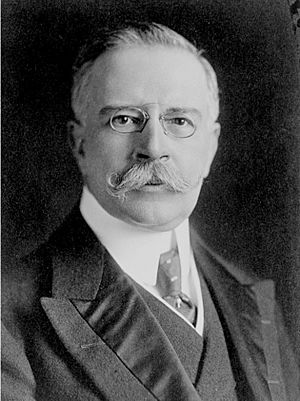Francisco León de la Barra facts for kids
Quick facts for kids
Francisco León de la Barra
|
|
|---|---|

Francisco León de la Barra, c. 1910
|
|
| 36th President of Mexico | |
| In office 25 May 1911 – 5 November 1911 |
|
| Vice President | Abraham González |
| Preceded by | Porfirio Díaz |
| Succeeded by | Francisco I. Madero |
| Secretary of Foreign Affairs | |
| In office 11 February 1913 – 4 July 1914 |
|
| President | Victoriano Huerta |
| Preceded by | Victoriano Huerta |
| Succeeded by | Carlos Pereyra |
| In office 1 April 1911 – 25 May 1911 |
|
| President | Porfirio Díaz |
| Preceded by | Enrique Creel |
| Succeeded by | Victoriano Salado Álvarez |
| Personal details | |
| Born | 16 June 1863 Querétaro, Querétaro, Mexican Empire |
| Died | 23 September 1939 (aged 76) Biarritz, France |
| Resting place | Père Lachaise Cemetery |
| Nationality | Mexican |
| Political party | Independent |
| Spouses | María Elena Borneque María del Refugio Borneque |
Francisco León de la Barra (born June 16, 1863, died September 23, 1939) was a Mexican politician and diplomat. He served as the 36th President of Mexico for a short time in 1911. People who supported traditional ways sometimes called him "The White President."
Contents
Early Life and Career
Francisco León de la Barra was born in Querétaro, Mexico. His father had moved to Mexico from Chile. Francisco studied law and became a lawyer. In 1891, he started his political career as a federal deputy. This meant he was a representative in the Mexican government.
In 1896, he joined Mexico's diplomatic service. A diplomat is someone who represents their country in other nations. He worked as an envoy, or official representative, in many countries. These included Brazil, Argentina, Belgium, the Netherlands, and the United States. He also represented Mexico at a peace conference in The Hague in 1907. During this time, he became known as an expert in international law. This is the set of rules that countries follow when dealing with each other.
Becoming President of Mexico
In 1910, the Mexican Revolution began. This was a major conflict where people fought against the government of President Porfirio Díaz. Díaz had been president for a very long time. When the revolution forced Díaz to resign in May 1911, Mexico needed a new leader.
Francisco León de la Barra was chosen to be the interim president. "Interim" means he would serve for a short time until new elections could be held. He was not a typical politician but a respected diplomat and lawyer. He took office on May 25, 1911.
Time as President
León de la Barra served as president until November 6, 1911. This is when Francisco I. Madero became the new president after winning the elections.
During his time as president, León de la Barra had three main goals. He wanted to bring back order to the country after the revolution. He also aimed to hold free and fair elections. Finally, he wanted to continue making reforms that had been promised.
One of his challenges was dealing with the revolutionary fighters. Madero had asked them to stop fighting and go home. However, some groups, like those led by Emiliano Zapata in Morelos, did not want to give up their weapons. León de la Barra sent troops to try and disarm these groups.
He also introduced some important changes. He increased funding for schools in rural areas. He worked on land reforms to make more land productive for farming. There were also labor reforms, like setting an eight-hour workday. These actions showed that even some older politicians saw the need for change in Mexico.
Later Career and Life
After his presidency, León de la Barra was elected as a senator in 1912. He later worked with the U.S. Ambassador to Mexico, Henry Lane Wilson. During a difficult period in February 1913, President Madero resigned and was later killed.
León de la Barra then served briefly as Foreign Minister under the new government of Victoriano Huerta. After this, he moved to Europe. He became the president of the Permanent Court of Arbitration in The Hague. This is a court that helps solve disagreements between countries.
He worked on several international committees after World War I. He also wrote many books about law and government. In 1939, he helped with talks between France and General Francisco Franco of Spain. This led to France recognizing Franco's government.
Francisco León de la Barra died in Biarritz, France, on September 23, 1939. He never returned to Mexico.
See also
 In Spanish: Francisco León de la Barra para niños
In Spanish: Francisco León de la Barra para niños

